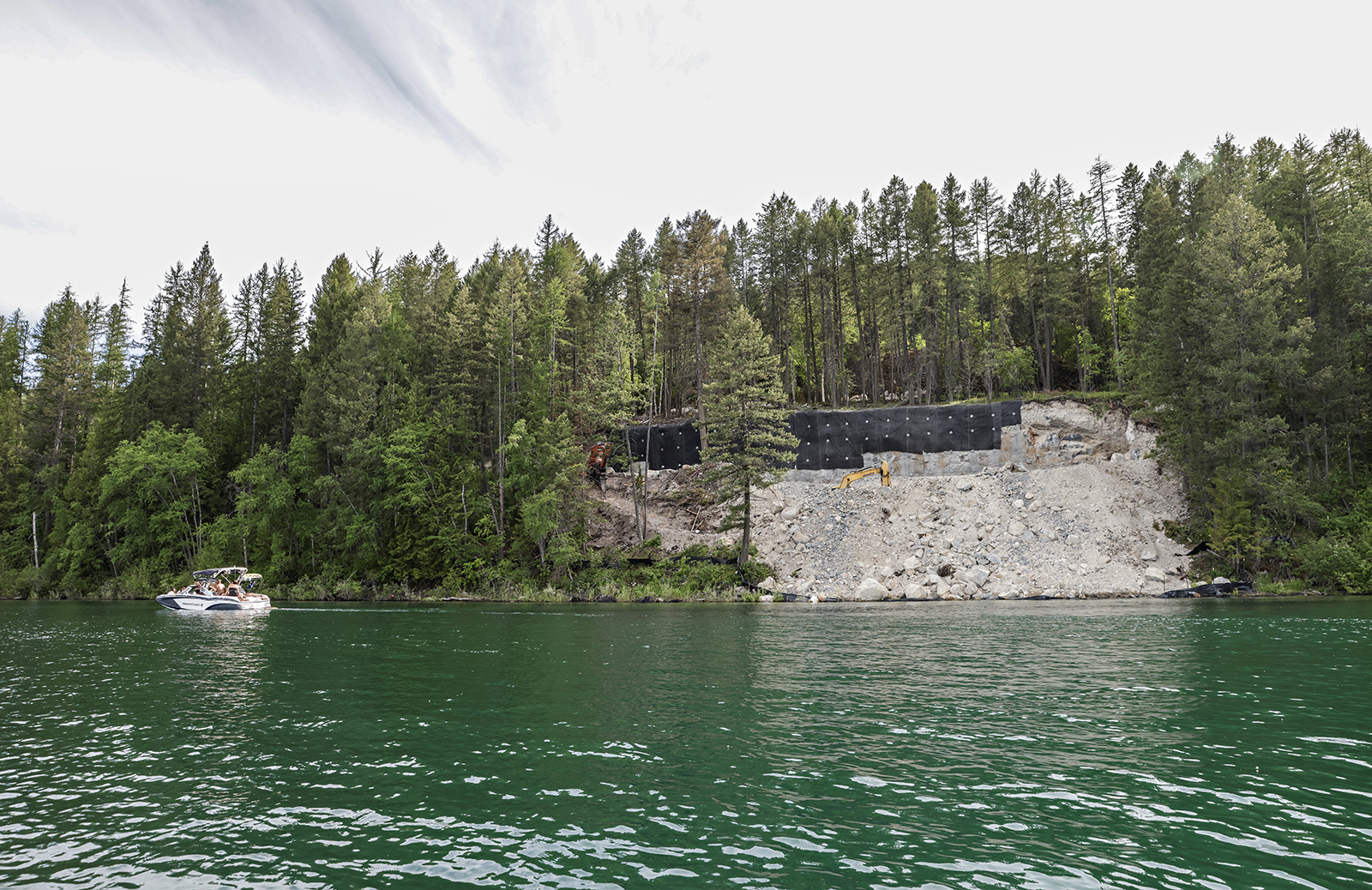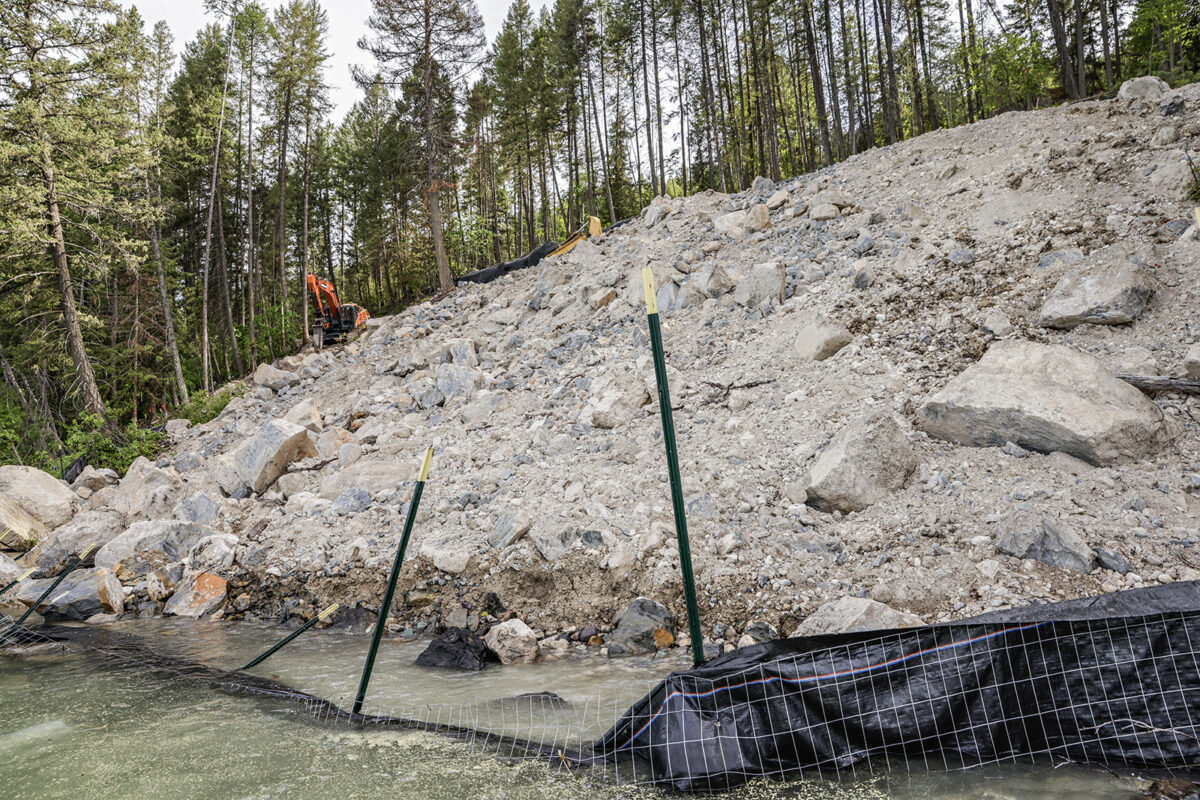Whitefish Lake Cleanup Plan Remains Murky as Regulators Untangle Jurisdictional Snarls
Local, state and federal agencies are puzzling out an environmental remediation plan after contractors triggered a landslide while blasting out the foundation for a home above Beaver Bay. With the plan weeks away from approval, Whitefish officials are calling on county leaders to revisit an interlocal agreement they say would streamline the response.
By Tristan Scott
With competing sets of regulations guiding development and oversight on Whitefish Lake, a raft of local, state and federal agencies is still puzzling out an environmental remediation plan after contractors triggered a landslide last month while blasting out a foundation above Beaver Bay. The delay has prompted Whitefish officials to urge an interlocal agreement with Flathead County that allows the city to reclaim enforcement authority, while also pressing for legislative reform to the state’s lakeshore protection law.
Meanwhile, the development that triggered the landslide — a years-long construction project to build a single-family residence on Lion Mountain Beach Lane — continues unabated. Because the construction site is located outside city limits and above the established boundary of the county’s lakeshore protection zone — a regulatory buffer that on the western edge of Whitefish Lake governs activities extending 20 feet above the low-water mark — Flathead County’s code compliance officers cannot issue a stop-work order. They did issue a partial stop-work order to halt blasting activities uphill from the lakeshore protection zone.
Walt Landi, owner of High Country Builders, has taken responsibility for the landslide, calling it an unfortunate incident that occurred after plans laid by a licensed blaster went awry. Landi said his crews had for months been using a hydraulic rock hammer to excavate the foundation, but the strategy was slow and generated daily complaints from a neighboring property owner.
“We hired a licensed blaster who assured us they would fracture the rock and that there would be very little upheaval whatsoever,” Landi said. “Obviously, the blast didn’t go expected.”
On May 29, the blast cleaved off a broad segment of the embankment and sent large boulders, rocks and debris onto the lakeshore and into the lake. Landi estimated that approximately 6 cubic yards of material is now spread across “close to 100 feet of lakeshore protection zone,” with several large rocks submerged beneath the lake’s surface.
“There’s very little actual dirt in the lake at all. It’s mostly just rocks,” Landi told members of the Whitefish Lake and Lakeshore Protection Committee on June 12. “This is unfortunate, but it is not going to have any type of lasting impact on the lake whatsoever.”
City officials and water quality experts in Whitefish disagree, however, characterizing the landslide as the most egregious lakeshore protection violation in 25 years and expressing frustration that an environmental remedy has been slow to take shape.
Mike Koopal, executive director of the Whitefish Lake Institute, a nonprofit research organization dedicated to protecting the lake’s health, said minimizing the environmental consequences to the lake sets a perilous example.
“This is a clear issue of nonpoint source pollution, and it literally translates to death by a thousand cuts,” Koopal said. “It’s all these smaller actions that cumulatively impact the lake. In this case, beyond the large material that entered the lake, what’s more concerning is the fine sediment entering the lake and increasing turbidity, reducing clarity, and effectively pulse-loading phosphorus into the lake which will cause algal production which then produces bacteria that robs the water of oxygen, which is needed to support the lake’s aquatic life. So, in this case, I think Walt Landi’s perspective is very myopic.”

Without a clear set of regulatory guidelines on Whitefish Lake, Koopal said it’s imperative that members of the development community act with integrity and professionalism while educating homeowners about threats to natural resources. He also said the incident underscores the need for legislative reform and a cooperative agreement between Flathead County and the city of Whitefish, for whom tensions surrounding jurisdictional authority on Whitefish Lake spans decades.
“As we are finding with the response to the Beaver Bay issue, there is a certain amount of frustration with Flathead County and their administration and response to lakeshore violation issues,” Koopal said. “Considering that Whitefish has annexed the lake, derives its municipal drinking water from the lake and much of its economic value is dependent on the lake, the community is invested in the resource. So, I really can’t imagine a better regulatory authority for the lake than the city of Whitefish, and that is the function of an interlocal agreement.”
Adopted by the state legislature in 1975, the Montana Lakeshore Protection Act is a piece of enabling legislation giving local jurisdictions the ability to draft lakeshore regulations. In the decade since a Montana Supreme Court ruling ceded control from the city of Whitefish to the county following a long-running legal battle over control of the planning “doughnut” ringing Whitefish, both the county and the city of Whitefish have administered divergent sets of lakeshore regulations. The result has led to an overlapping jurisdictional matrix and, some say, an ineffective and antiquated regulatory framework.
Koopal said he’s seeking recommendations from all agencies with lakeshore regulation authority to determine “how we could add value to the state’s lakeshore protection act.”
Jim Stack, a Whitefish Lake resident and former chairman of the Whitefish Lake and Lakeshore Protection Committee, said he couldn’t script a better example of regulatory dysfunction than the latest violation and the muddled response it elicited, especially considering that the contractors working on the Beaver Bay property have already been cited for a separate lakeshore protection violation for illegally removing trees.
“During my tenure on the lakeshore committee, we saw this a surprising number of times — particularly with high net-worth property owners — where a repeat violation would occur in order to achieve a finished objective … knowing that the worst that could happen is a fine and partial restoration to a violation that couldn’t fully be restored,” Stack said. “In the end, the property owner simply paid a financial price for what they wanted but which wasn’t allowed by lakeshore regulations.”
Last year, High Country Builders was cited for removing between 50 and 60 trees from the lakeshore’s slope within the lakeshore protection zone without a permit. After Flathead County officials received a complaint about the activity, the contractors were allowed to apply for an “after-the-fact” permit, according to Jared Schroeder, one of two code compliance technicians in Flathead County. Although the permit was issued in arrears and remains in good standing today, the county doubled the fine for the lakeshore protection violation, Schroeder said, amounting to an $860 penalty.
For Stack, the county’s enforcement authority limits the city’s ability to enforce its own lakeshore protection zone laws. Meanwhile, the county doesn’t have a building department so it can’t regulate any building activity that occurs outside of either the lakeshore protection zone or the floodplain, and its enforcement division is stretched too thin to respond each violation and approve a remedy in a timely manner.
Flathead County Planning and Zoning Director Erik Mack said the county’s two code compliance technicians are currently tasked with responding to 10 new open violations they received in the last 30 days, as well as 13 open floodplain violations, 12 open subdivision violations, 40 open zoning violations, 10 lakeshore violations, and 36 community-decay violations.
According to Mack, High Country Builders will likely be fined for a lakeshore protection zone violation as well as a floodplain violation. Because the contractor must apply for after-the-fact permits for each violation, Mack said the county’s fee structure quadruples the fine amount to $1,720 on each count.
Mack said it’s difficult to estimate a timeline for the cleanup because, even after the contractors submit a cleanup plan, multiple agencies must review it, ensure that “it complies with each set of regulations that they are responsible for enforcing” and approve it before the county signs off.
“And each case requires multiple site visits to make sure the cleanup is on track, and, obviously, we’re a big county so it takes a long time to conduct those site visits,” Mack said this week.

In the weeks since the landslide was reported, a multitude of agencies has responded, including the state Department of Environmental Quality (DEQ), which opened an investigation into the incident and is coordinating a remediation strategy with the site’s building contractors, as well as with Flathead County’s code compliance officer. Other agencies consulted on the violation and attendant cleanup plan include the Montana Department of Natural Resources and Conservation (DNRC), which determined that it does not have jurisdiction to enforce a violation or oversee a cleanup remedy because the damage occurred above the lake’s low-water mark, said Kari Nielsen, the DNRC’s land use planner for the Northwestern Land Office. Moreover, contractors intend to begin work in February, when the lakes is at its lowest surface level, limiting cleanup activities to a jurisdictional zone above the low-water mark and outside the DNRC’s jurisdiction, Nielsen said. The U.S. Army Corps of Engineers has also been consulted about a potential federal Clean Water Act violation.
According to DEQ, High Country Builders did not have coverage under a stormwater construction general discharge permit for the construction activities.
“DEQ is currently assessing whether coverage was required for the construction activity that led up to the rockslide,” according to an agency spokesperson. “If we determine coverage under the general permit was required and was not in place during construction, this would be a violation of the Montana Water Quality Act and DEQ would follow its normal process for issuing a violation letter, identifying corrective action (such as getting the appropriate permit coverage), and determining whether penalties are appropriate.”
Following the rockslide, any activity to remove debris from the lake will require a temporary turbidity 318 authorization from DEQ. This allows for turbidity, or sedimentation, resulting from short-term construction-related activities affecting state waters. A 318 authorization includes requirements and best management practices.
As of June 14, the contractor had not applied to DEQ for a 318 authorization. Applications are processed between 30 and 60 days, although they typically are completed in closer to two weeks, according to the spokesperson.
“This is the last thing that I wanted, and we deeply regret it happening,” Landi said. “I’ll give everyone my word that this will be cleaned up. But right now, our hands are tied. We’ve contacted a dozen different agencies to see if we can go in and clean it up and their instructions are to wait for the county.”
Landi said a turbidity curtain is on order and should arrive any day to help contain the sediment in Beaver Bay.
Koopal said sediment and debris will continue to discharge into the lake with every rain or storm event.
Rachel Schmidt, who grew up in Whitefish, told members of the Whitefish Lake and Lakeshore Committee that the recent incident highlights the urgent need for reform of state and local lakeshore protection laws.
“We are already facing growing drought, aggressive wildfire, changing climate, reckless residential development, septic contamination, aquatic invasive species, particulate contamination, continual industrial railway derailments, and spills,” Schmidt said. “While what is happening to Whitefish Lake is often referred to as a death by 1,000 cuts, our latest assault on our lake — the blasting at Beaver Bay — represents a hemorrhaging gash that should be a wake-up call to all residents of Whitefish and the state. The current regulations are not enough. The current punishments are not enough, and current enforcement is not enough to protect our lake from all of these currently active impacts.”
“That violation never should have happened,” Stack added. “But when a planning office and a governing body don’t step up to enforce repeated violations, this is what happens. This is an embarrassment.”